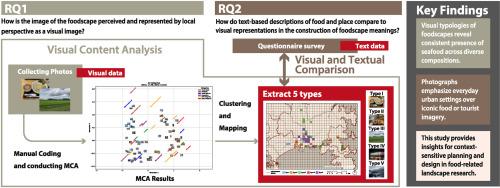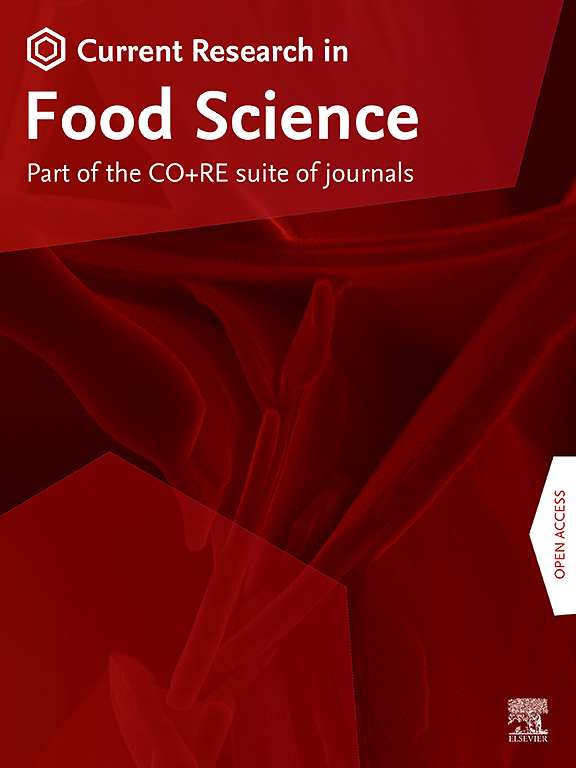Local perceptions of foodscapes and their representation in visual and texts: A visual content analysis of photography in Japanese coastal area
IF 7
2区 农林科学
Q1 FOOD SCIENCE & TECHNOLOGY
引用次数: 0
Abstract
The term “foodscape” has recently gained prominence in academic discourse, fostering interdisciplinary research into the relationship between food and local environments. This study focuses on the material aspect of foodscapes and aims to clarify how local residents perceive them. We also analyze differences between visual and textual expressions. Targeting university students in the coastal area of Japan, Ishinomaki district, Miyagi Prefecture, the research employs visual materials (photographs) and textual responses (questionnaire).
First, focusing on landscape aspects of foodscape—particularly visual views—we conducted photo-based analysis based on expert judgement using visual parameters: visual object, viewpoint, visual distance, and perspective. Participants photographed scenes associated with “foodscapes.” Multiple Correspondence Analysis (MCA) categorized images into five types. Results showed relationships between food categories and photo composition, but seafood—an important local industry—appeared across almost all types regardless of visual parameters.
Second, comparative analysis of photographs and textual responses elucidated how food and place are jointly imagined in local foodscapes. Compared with a preliminary survey of regional specialties and landmarks, photographs showed decreased seafood imagery and increased restaurant and retail scenes, mostly in urban areas. Findings suggest that when foodscapes are visually expressed through non-verbal media such as photography, imagery emphasizes familiar daily settings—particularly sites related to food production and distribution—rather than iconic regional foods or tourist landmarks.
The analytical perspective of this study provides a framework for developing context-sensitive approaches reflecting residents’ sense of place in food tourism, regional planning, and cultural landscape research.

当地对食物景观的感知及其在视觉和文本中的表现:日本沿海地区摄影的视觉内容分析
“食物景观”一词最近在学术话语中获得了突出地位,促进了对食物与当地环境之间关系的跨学科研究。本研究侧重于食物景观的物质方面,旨在阐明当地居民如何感知它们。我们还分析了视觉表达和文本表达的差异。本研究以日本沿海地区宫城县石卷县的大学生为对象,采用视觉材料(照片)和文字回答(问卷)。首先,关注食物景观的景观方面,特别是视觉视图,我们使用视觉参数(视觉对象、视点、视觉距离和视角)进行基于专家判断的基于照片的分析。参与者拍摄与“美食景观”相关的场景。多重对应分析(MCA)将图像分为五种类型。结果显示,食物种类与照片构图之间存在关系,但无论视觉参数如何,海鲜——一种重要的当地产业——几乎出现在所有类型的照片中。其次,通过对照片和文本回应的对比分析,阐明了食物和地方是如何在当地食物景观中共同想象的。与对地区特色和地标的初步调查相比,照片显示海鲜图像减少,餐馆和零售场景增加,主要在城市地区。研究结果表明,当食物景观通过非语言媒体(如摄影)进行视觉表达时,图像强调熟悉的日常环境,特别是与食物生产和分配有关的地点,而不是标志性的地区食物或旅游地标。本研究的分析视角为食物旅游、区域规划和文化景观研究中反映居民地方感的情境敏感方法提供了一个框架。
本文章由计算机程序翻译,如有差异,请以英文原文为准。
求助全文
约1分钟内获得全文
求助全文
来源期刊

Current Research in Food Science
Agricultural and Biological Sciences-Food Science
CiteScore
7.40
自引率
3.20%
发文量
232
审稿时长
84 days
期刊介绍:
Current Research in Food Science is an international peer-reviewed journal dedicated to advancing the breadth of knowledge in the field of food science. It serves as a platform for publishing original research articles and short communications that encompass a wide array of topics, including food chemistry, physics, microbiology, nutrition, nutraceuticals, process and package engineering, materials science, food sustainability, and food security. By covering these diverse areas, the journal aims to provide a comprehensive source of the latest scientific findings and technological advancements that are shaping the future of the food industry. The journal's scope is designed to address the multidisciplinary nature of food science, reflecting its commitment to promoting innovation and ensuring the safety and quality of the food supply.
 求助内容:
求助内容: 应助结果提醒方式:
应助结果提醒方式:


